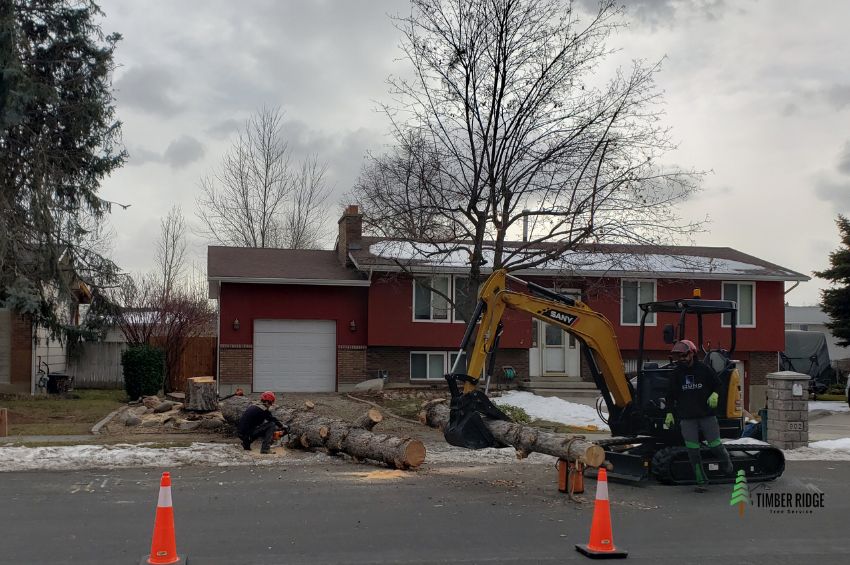
In the grand narrative of urban and suburban landscapes, trees are the silent protagonists, casting their leafy embrace over residences and businesses alike. Their presence is not just aesthetic; it's a testament to the delicate balance between nature and human habitation. Yet, there comes a time when the decision to remove a tree becomes a necessary chapter in this arboreal story, whether for the safety of inhabitants, the health of the tree, or the practical demands of development. When that time comes, Timber Ridge Tree Service is at your service.
Residential and commercial spaces alike often find themselves confronted with the decision to remove a tree. It's a decision laden with considerations that extend beyond the physical act of cutting down branches. It requires a thoughtful examination of the tree's overall health, its impact on its surroundings, and the potential risks it may pose in the future.
One primary reason for considering tree removal is safety. As trees mature, their branches become laden with the weight of years. In regions prone to storms or adverse weather conditions, this burden can transform seemingly sturdy limbs into potential hazards. The risk of branches breaking and falling increases, especially if the tree has deadwood, disease, or structural weaknesses. In such instances, the decision to remove the tree is not just about preservation but about safeguarding lives and property from the unpredictable consequences of nature.
The health of the tree itself is another pivotal factor. Trees, like any living organisms, can fall victim to diseases, infestations, or environmental stressors. When a tree reaches a state where its vitality is compromised beyond recovery, removal becomes a responsible choice. Addressing diseases promptly is crucial, but when the extent of damage is irreversible, the decision to remove the tree ensures the prevention of further harm, both to the tree and its surroundings.
The impact of a tree on its immediate environment should not be underestimated. In urban and suburban settings, trees may encroach upon power lines, structures, or other vegetation. When the growth of a tree begins to compromise the integrity of nearby infrastructure or poses a threat to the health of other trees, the choice to remove it becomes a strategic one. The delicate dance between nature and human habitation requires occasional interventions to maintain the equilibrium.
The changing needs of residential or commercial spaces may necessitate tree removal. As properties undergo development or expansion, trees that once stood harmoniously within the landscape may find themselves in the path of progress. While it's an inevitability in the face of urbanization, the decision to remove a tree in these circumstances underscores the dynamic relationship between nature and the built environment. It's an acknowledgment of the evolving needs of space and a conscious effort to integrate development without compromising ecological balance.
In commercial settings, the decision to remove a tree may also hinge on aesthetic considerations. Businesses often invest in creating an inviting and professional exterior, and the presence of a diseased or unsightly tree can detract from this visual appeal. While the removal of a tree for purely aesthetic reasons may seem less rooted in necessity, it aligns with the broader understanding that the external presentation of a business contributes to its overall identity and success.
The process of tree removal is not a one-size-fits-all solution. It involves a nuanced understanding of the specific characteristics of the tree, the surrounding environment, and the desired outcome. Professional arborists play a crucial role in this decision-making process. Their expertise extends beyond wielding chainsaws; it encompasses a deep understanding of tree biology, pathology, and the intricate interplay between trees and their surroundings.
Additionally, the disposal of a felled tree is an aspect that requires careful consideration. While the removal of a tree is a necessary step, responsible disposal methods ensure that the ecological impact is minimized. Recycling the wood for mulch, repurposing it for furniture or art, or using it for firewood are environmentally conscious alternatives to simply discarding the remains. In this way, the cycle of a tree's life continues, contributing even in its afterlife to the well-being of the ecosystem.
The decision to remove a tree from residential or commercial spaces is a multifaceted one that requires a delicate balance between ecological considerations, safety concerns, and the evolving needs of the space. It's a recognition that the story of trees in our urban and suburban landscapes is not a static tale but an evolving narrative that demands occasional interventions. When approached with a deep understanding of the tree's health, its impact on its surroundings, and the intricacies of urban development, tree removal becomes a responsible and necessary chapter in the continuing story of the delicate dance between nature and human habitation. Contact Timber Ridge Tree Service today for all your tree removal needs, residential or commercial.